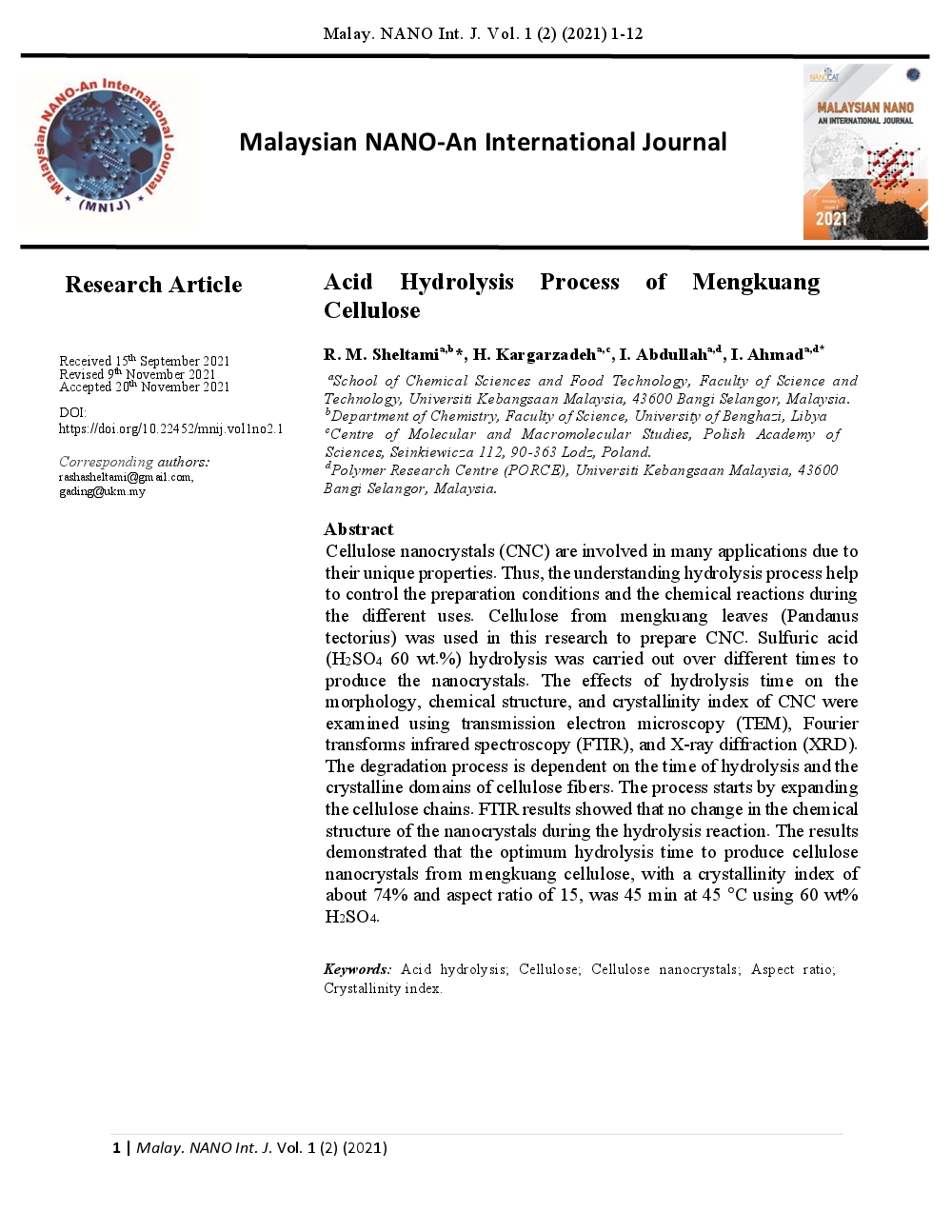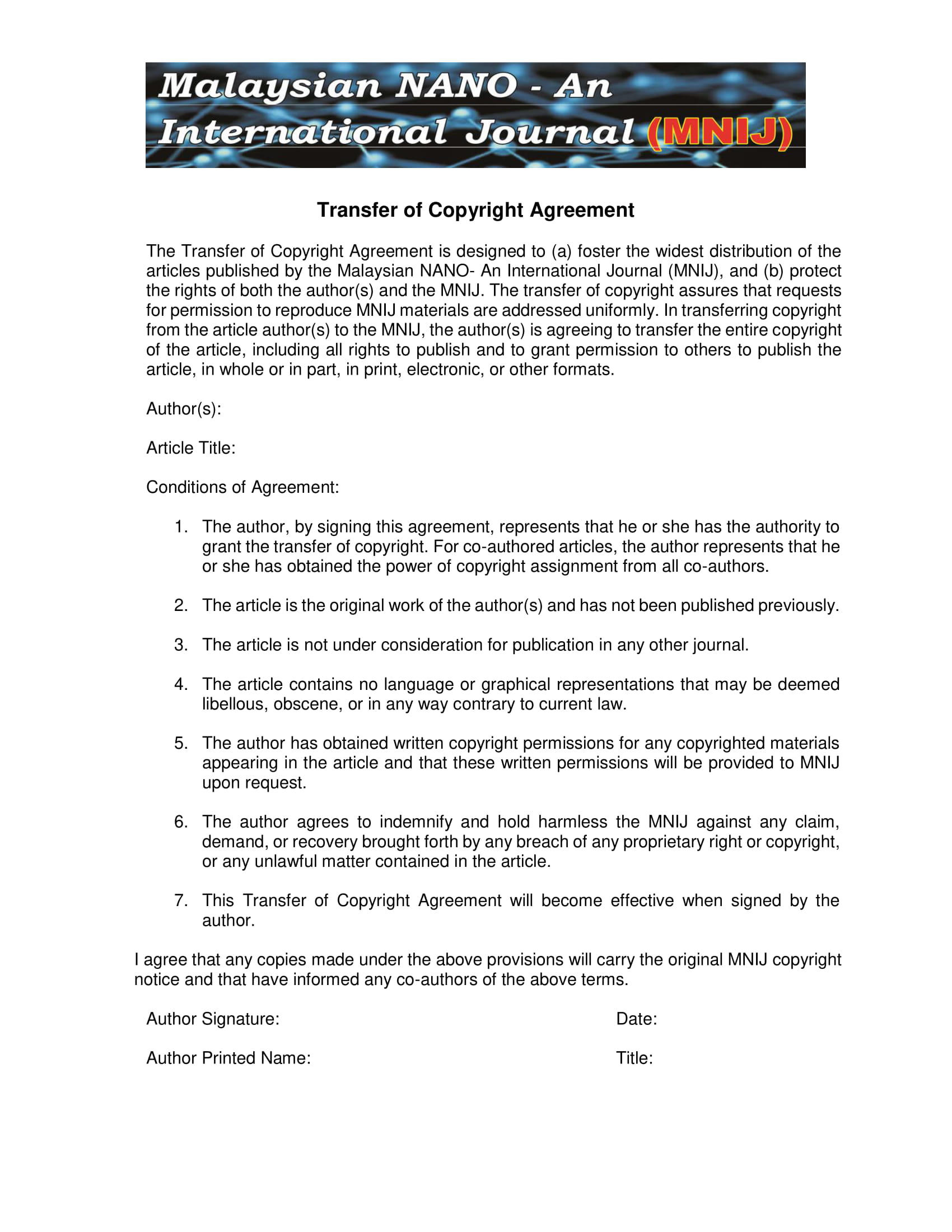Acid hydrolysis process of mengkuang cellulose
DOI:
https://doi.org/10.22452/mnij.vol1no2.1Keywords:
Cellulose, Cellulose nanocrystals, Aspect ratio, Crystallinity index, : Acid hydrolysisAbstract
Cellulose nanocrystals (CNC) are involved in many applications due to their unique properties. Thus, the understanding hydrolysis process help to control the preparation conditions and the chemical reactions during the different uses. Cellulose from mengkuang leaves (Pandanus tectorius) was used in this research to prepare CNC. Sulfuric acid (H2SO4 60 wt.%) hydrolysis was carried out over different times to produce the nanocrystals. The effects of hydrolysis time on the morphology, chemical structure, and crystallinity index of CNC were examined using transmission electron microscopy (TEM), Fourier transforms infrared spectroscopy (FTIR), and X-ray diffraction (XRD). The degradation process is dependent on the time of hydrolysis and the crystalline domains of cellulose fibers. The process starts by expanding the cellulose chains. FTIR results showed that no change in the chemical structure of the nanocrystals during the hydrolysis reaction. The results demonstrated that the optimum hydrolysis time to produce cellulose nanocrystals from mengkuang cellulose, with a crystallinity index of about 74% and aspect ratio of 15, was 45 min at 45 °C using 60 wt% H2SO4.
Downloads
References
M.Tsuji, R.S.J. Manley. Image analysis in the electron microscopy of cellulose protofibrils. Colloid & Polymer Science. 1984; 262: 236–244.
N. Lavoine, I. Desloges, A. Dufresne, J. Bras. Microfibrillated cellulose – its barrier properties and applications in cellulosic materials: a review. Carbohydrate Polymers. 2012; 90: 735–764.
O.A. Battista, P.A. Smith. Microcrystalline cellulose. Industrial & Engineering Chemistry. 1962; 54: 20–29.
A. Dufresne. Nanocellulose: from nature to high performance tailored materials. Berlin: Walter de Gruyter GmbH & Co KG. 2018.
Y. Habibi, L.A. Lucia, O.J. Rojas. Cellulose nanocrystals: chemistry, self-assembly, and applications. Chemical reviews. 2010; 110: 3479–3500.
M.A.S. Azizi Samir, F. Alloin, A. Dufresne. Review of recent research into cellulosic whiskers, their properties, and their application in nanocomposite field. Biomacromolecules. 2005; 6: 612–626.
P. Lu, Y.L. Hsieh. Preparation and properties of cellulose nanocrystals: rods, spheres, and network. Carbohydrate Polymers. 2010; 82: 329–336.
A. Pakzad, J. Simonsen, P.A Heiden, R.S. Yassar. Size effects on the nanomechanical properties of cellulose I nanocrystals. Journal of Materials Research. 2012; 27: 528–536.
M.N. Anglès, A. Dufresne. Plasticized starch/tunicin whiskers nanocomposites. Structural analysis. Macromolecules. 2000; 33: 8344–8353.
K. Zineb, K. Ihsane, H. Hassan, B. Rachid, Q. Abou El Kacem. Tomato plant residue as new renewable source for cellulose production: extraction of cellulose nanocrystals with different surface functionalities. Cellulose. 2020; 27: 4287–4303.
N. Pandi, S.H. Sonawane, K.A Kishore. Synthesis of cellulose nanocrystals (CNCs) from cotton using ultrasound-assisted acid hydrolysis. Ultrasonics sonochemistry. 2021; 70: 105353. [12] S. Lu, T. Ma, X. Hu, J. Zhao, X. Liao, Y. Song, X. Hu. Facile extraction and characterization of cellulose nanocrystals from agricultural waste sugarcane straw. Journal of the Science of Food and Agriculture. 2021.
N.T.U. Culsum, C. Melinda, I. Leman, A. Wibowo, Y.W. Budhi. Isolation and characterization of cellulose nanocrystals (CNCs) from industrial denim waste using ammonium persulfate. Materials Today Communications. 2021; 26: 101817.
R.M. Sheltami, I. Abdullah, I. Ahmad. Structural Characterisation of Cellulose and Nanocellulose Extracted from Mengkuang Leaves. Advanced Materials Research. 2012; 545: 119–123.
R.M. Sheltami, I. Abdullah, I. Ahmad, A. Dufresne, H. Kargarzadeh. Extraction of cellulose nanocrystals from mengkuang leaves (Pandanus tectorius). Carbohydrate Polymers. 2012; 88: 772–779.
L. Segal, J.J. Creely, A.E. Martin, C.M. Conrad. An empirical method for estimating the degree of crystallinity of native cellulose using the X-ray diffractometer. Textile Research Journal. 1959; 29; 786–794.
H.J. Philipp, M.L. Nelson, H.M. Ziifle. Crystallinity of cellulose fibers as determined by acid hydrolysis. Textile Research Journal. 1947; 17: 585–596.
S. Elazzouzi-Hafraoui, Y. Nishiyama, J.L. Putaux, L. Heux, F. Dubreuil, C. Rochas. The shape and size distribution of crystalline nanoparticles prepared by acid hydrolysis of native cellulose. Biomacromolecules. 2008; 9: 57–65.
S.J. Eichhorn, A. Dufresne, M. Aranguren, N.E. Marcovich, J.R. Capadona, S.J. Rowan, C. Weder, W. Thielemans, M. Roman, S. Renneckar et al. Review: current international research into cellulose nanofibres and nanocomposites. Journal of Materials Science. 2010; 45: 1–33. [20] D.N.S. Hon, N. Shiraishi. Wood and Cellulosic Chemistry. New York: Marcel Dekker, Inc. 2001.
A. Alemdar, M. Sain. Isolation and characterization of nanofibers from agricultural residues - Wheat straw and soy hulls. Bioresource Technology. 2008; 99: 1664–1671.
D. Bondeson, A. Mathew, K. Oksman. Optimization of the isolation of nanocrystals from microcrystalline cellulose by acid hydrolysis. Cellulose. 2006; 13: 171–180.
O.A. Battista. Hydrolysis and crystallization of cellulose. Industrial & Engineering Chemistry. 1950; 42: 502–507.
G. Sèbe, F. Ham-Pichavant, E. Ibarboure , A.L.C. Koffi, P. Tingaut. Supramolecular structure characterization of cellulose II nanowhiskers produced by acid hydrolysis of cellulose I substrates. Biomacromolecules. 2012; 13: 570–578.
P. Hermans, A. Weidinger. Change in crystallinity upon heterogeneous acid hydrolysis of cellulose fibers. Journal of Polymer Science. 1949; 4: 317–322.

Downloads
Published
How to Cite
Issue
Section
License





